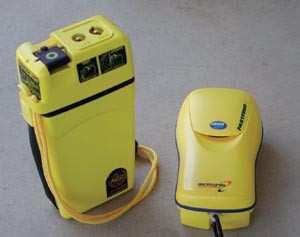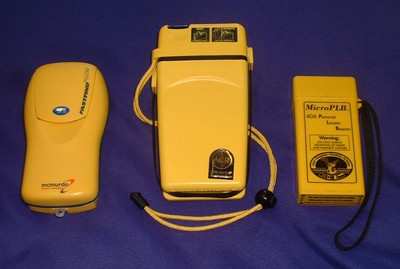Some Work Poorly, Some Just Don't Work
 All GPS-equipped 406 MHz Personal
Locator Beacons (PLBs) and marine Emergency Position Indicating
Radio Beacon (EPIRBs) are not created equal. In a finding of a
recent test of PLBs and EPIRBs from three manufacturers, the GPS
location function of one manufacturer's products routinely failed
to acquire a GPS location when tested under other than ideal
conditions. An equally important test finding was that the
international standards to certify the GPS-enabled 406 MHz beacons
fail to take into account the real-world conditions that often
exist when beacons are activated.
All GPS-equipped 406 MHz Personal
Locator Beacons (PLBs) and marine Emergency Position Indicating
Radio Beacon (EPIRBs) are not created equal. In a finding of a
recent test of PLBs and EPIRBs from three manufacturers, the GPS
location function of one manufacturer's products routinely failed
to acquire a GPS location when tested under other than ideal
conditions. An equally important test finding was that the
international standards to certify the GPS-enabled 406 MHz beacons
fail to take into account the real-world conditions that often
exist when beacons are activated.
PLBs became legal in the continental US last July and many
pilots have purchased them as a practical and affordable
alternative to installing a 406 MHz ELT, an expensive proposition.
The FAA has even gone on record as recommending them to General
Aviation pilots who want the advantages of 406 MHz distress
alerting. They have the added advantage of being able to also be
taken along on outdoor sports or boating activities, not being tied
to the aircraft as is an ELT.
PLBs have been particularly popular for outdoor sports
enthusiasts who venture beyond well traveled trails and
campgrounds, out of bounds skiers, paddlers of wilderness rivers
and the like. GPS-enabled EPIRBS have been available for
boats for a number of years and many boaters are also looking to
PLBs as a more compact and potentially less expensive
alternative.
The test was conducted by the Equipped to Survive Foundation and
funded in part by BoatUS Foundation for Boating Safety and Clean
Water and West Marine. The beacons were specifically tested for
their GPS functionality, or their ability to "self-report" their
location to Geostationary (GEO) satellites, which can relay the
location information nearly instantaneously to rescuers. Other
issues such as battery life and signal attenuation in some
real-world conditions were also examined.
 All of the tested emergency beacons
primarily use the 406 MHz distress alerting frequency in
conjunction with the COSPAS-SARSAT system of Low Earth Orbit
satellites and Doppler principles to provide position information.
The report did find that all of the tested beacons successfully
allowed a Doppler location to be derived - even in circumstances
such as the bottom of a narrow and deep gorge - a minimal
acceptable level of distress alerting. However, the purpose of
GPS-enhanced 406 MHz beacons is to save precious rescue time by
supplying much more precise location information via their own
GPS-derived location through GEO satellites - ever present in the
sky - rather than waiting for an orbiting satellite to appear in
view and then obtain a less accurate Doppler computed location.
All of the tested emergency beacons
primarily use the 406 MHz distress alerting frequency in
conjunction with the COSPAS-SARSAT system of Low Earth Orbit
satellites and Doppler principles to provide position information.
The report did find that all of the tested beacons successfully
allowed a Doppler location to be derived - even in circumstances
such as the bottom of a narrow and deep gorge - a minimal
acceptable level of distress alerting. However, the purpose of
GPS-enhanced 406 MHz beacons is to save precious rescue time by
supplying much more precise location information via their own
GPS-derived location through GEO satellites - ever present in the
sky - rather than waiting for an orbiting satellite to appear in
view and then obtain a less accurate Doppler computed location.
Equipped to Survive Founder Doug Ritter said, "Unfortunately, in
the testing, the off-the-shelf McMurdo Ltd. 'Precision 406
MHz GPS EPIRB' (also known as G4 406 MHz GSP EPIRB)and McMurdo Ltd.
'Fastfind Plus 406 MHz Personal Location Beacon' (also known as the
Fastfind Plus 406 MHz PLB) failed to reliably acquire a GPS
location 'fix' under operational 'real-world conditions.' The tests
revealed that purchasers of these GPS-equipped 406 MHz beacons -
who paid a premium for the added GPS technology in anticipation of
potentially shortening rescue response with faster location
information and increased location precision - are apparently not
getting what they paid for, and are operating under false
expectations. This lack of GPS data could result in tragedy that
might have otherwise been prevented," continued Ritter.
BoatUS Foundation President Ruth Wood said, "Emergency beacons
are often called upon to send an alert during inclement weather or
less-than-perfect conditions. We tested the six beacons aboard a
life raft, floated them in the water tethered to an inflatable or
held by a swimmer in moderate one-to-eight-foot swells, the study
showed clearly that the not all these beacons operated equally,"
she said. Inland performance was mixed, with McMurdo's PLB failing
to acquire a GPS fix where handheld GPS receivers had no difficulty
acquiring a location.
The evaluation was divided into three distinct phases: Baseline,
Maritime and Inland. Within each of the latter two phases, a series
of tests was designed to replicate real-world conditions, with
variables such as sea state, limited horizon, forest canopy,
mountains and the number of GPS satellites in view.
On the water, the McMurdo beacons failed to acquire a GPS
location in all planned scenarios tested. The McMurdo EPIRB
did acquire a location on the water in one instance when it was
given a special opportunity with ideal conditions. The ACR
EPIRBs acquired a location in all but one tested scenarios.

Inland performance was mixed, with McMurdo's PLB failing to
acquire a GPS fix in a small forest clearing where handheld GPS
receivers had no difficulty acquiring a location, in a simulated
rain scenario, or when initially activated with an obscured sky
view and then relocated to where it could view the GPS satellites.
In the baseline testing, the McMurdo PLB failed to acquire a new
location when relocated. McMurdo's marine GPS-enabled "Precision"
EPIRB did similarly poorly in the marine tests. The conclusion is
that users of the McMurdo self-locating beacons may expect to find
that GPS-derived location may not be transmitted unless
environmental conditions are generally benign and the beacon is
stable, and unless there is a largely uninterrupted sky view
covering most of 180 degrees above and 360 degrees around the
beacon location. The ACR Electronics GyPSI PLB and Techtest 500-27
PLB fared much better.
Additionally, the study identified other factors that could
impact a 406 MHz beacon's GPS performance, as well as some generic
406 MHz beacon flaws worthy of note. A PLB that relies on an
external GPS source is entirely dependent on the performance of
that external GPS source - and the quality of GPS receivers varies
significantly; submerging the base of some PLBs' antenna in water
can adversely affect their ability to successfully transmit an
alert under some conditions or to provide an effective 121.5 MHz
homing signal.
The Equipped to Survive Foundation issued 17 specific
Conclusions and 23 critical Recommendations for action based on the
test results. Said Ritter, "The bottom line is that while the
international COSPAS-SARSAT system does an extraordinary job of
saving lives, the COSPAS-SARSAT testing standard for GPS
performance needs to better reflect real-world conditions. Consumer
expectations regarding performance of these emergency beacons are
very high - this is one area where those expectations must be
better met."
 ANN's Daily Aero-Linx (05.06.25)
ANN's Daily Aero-Linx (05.06.25) ANN's Daily Aero-Term (05.06.25): Ultrahigh Frequency (UHF)
ANN's Daily Aero-Term (05.06.25): Ultrahigh Frequency (UHF) ANN FAQ: Q&A 101
ANN FAQ: Q&A 101 Classic Aero-TV: Virtual Reality Painting--PPG Leverages Technology for Training
Classic Aero-TV: Virtual Reality Painting--PPG Leverages Technology for Training Airborne 05.02.25: Joby Crewed Milestone, Diamond Club, Canadian Pilot Insurance
Airborne 05.02.25: Joby Crewed Milestone, Diamond Club, Canadian Pilot Insurance





